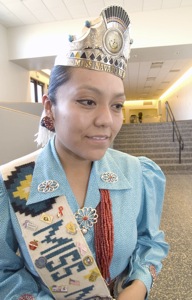-
- Same-sex marriage backers want to open Massachusetts to out-of-state couples
- Ellen DeGeneres wins big at Daytime Emmys
- Dallas chooses Leppert as next mayor
- ABC studio made business calculation in dumping Isaiah Washington from ‘Grey’s Anatomy’
- Navajos continue to battle HIV/AIDS despite cultural taboos
- Testing of people at high risk for AIDS suggested
- National News Briefs
- World News Briefs
national
Navajos continue to battle HIV/AIDS despite cultural taboos
Progress cited but many still do not seek treatment if they test positive
Published Thursday, 21-Jun-2007 in issue 1017
CHINLE, Ariz. (AP) – In recent months, Jocelyn Billy’s willingness to discuss topics such as sex, relationships and disease on the Navajo Nation has won praise from those working with HIV/AIDS patients.
While many Navajo officials shy away from those subjects, the 24-year-old Billy has used her unique and prominent status as Miss Navajo Nation to get the word out.
“For her to talk about HIV and STDs is phenomenal,” said Marco Arviso of the Navajo AIDS Network.
On the 27,000-square-mile Navajo Nation, the challenges in addressing sexually transmitted diseases are many. Among them: How to relay to traditional healers that HIV/AIDS are not non-native diseases, how to obtain services when the nearest clinic is sometimes hours away and how to ensure patient confidentiality in often close-knit communities.
Also, how to overcome a Navajo belief that to speak of death and disease is to bring it upon oneself or a loved one.
But as long as Navajos ignore the problems and fail to educate the community about how the diseases are contracted and how to deal with people living with AIDS, the more divided communities will become, Billy said.
“That’s not our way of life as Dine people,” she said.
Beyond the Navajo Nation, the overall rate of HIV/AIDS diagnosis for American Indians and Alaska Natives has been higher than that for whites since 1995, but generally lower than blacks or Hispanics, according to the Centers for Disease Control (CDC) and Prevention.
In 2005, data from the CDC showed that the rate of HIV/AIDS diagnosis for American Indians and Alaska Natives was 10.6 per 100,000, compared with 72.8 for blacks, 28.5 for Hispanics, 9.0 for whites and 7.6 for Asians and Pacific Islanders.
Among Navajo-area American Indians, the incidence rate was 7.6 per 100,000 for the same year and slightly higher in 2006 at 7.8 per 100,000.
The Navajo Area Indian Health Service identified a total of 240 HIV/AIDS cases among the group between 1985 and 2006.
“Things for the moment seem to have stabilized,” said Jonathan Iralu, the infectious disease consultant for the health service. “We’re thankful things look good right now.”
Four years ago, one statistic caught the attention of the health care community – the first local transmission of HIV/AIDS. Before then, it was believed that all cases were coming in from off the reservation.
Tribal officials responded with public service announcements on radio, TV and in newspapers, urging Navajos to practice safe sex, get tested and learn how to prevent the spread of HIV/AIDS.
In 2003, the number of new cases climbed to 24, up from 15 the previous year.
|
|
Copyright © 2003-2025 Uptown Publications


